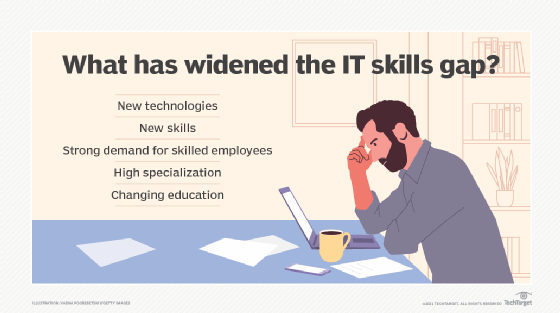skills taxonomy
What is a skills taxonomy?
A skills taxonomy is a classification system for all the skills an employee at a business may have. It provides a common framework for seeking, assessing, growing, measuring and cultivating key skills in the business.
Human resources (HR) leaders can use skills taxonomies to organize skills and use them to fulfill specific business functions. Skills taxonomies also give HR professionals a common language for talking about skills. Building a common language for skills is sometimes called a skills ontology.
Skills taxonomies can be incorporated into learning and development platforms, performance management systems, talent management software and other HR information systems.
Products with more advanced skills taxonomy features can use contextual information about a prospective employee, such as work history or LinkedIn connections, to infer the kinds of skills a prospective employee has. For example, if the employee worked at Google in the early 2000s in the software engineering department, the program could deduce that the employee has the skills to work with the machine learning technology that Google was using during that period.
Benefits of a skills taxonomy
Skills taxonomies make it easier to do the following:
- Find internal candidates for projects.
- Identify skills gaps between individuals and jobs.
- Automatically match candidates to job openings.
- Find career paths between similar jobs. Skills taxonomies do this by creating a common language to describe skills and then match skills to roles, business objectives and training materials.
One of the main benefits of a skills taxonomy is that it lets companies view skills at a granular level. Employers can get a broader view of the employee beyond the confines of their job. Instead of seeing an employee as just a software engineer, a skills taxonomy helps the employer see someone in that role with a variety of transferable skills. Companies use skills taxonomies to take a skills-based approach to the employee instead of a role-centric one.
Companies have a lot of data about their employees. Any time a company makes a decision about an employee -- i.e., who to hire, how much to give for a raise, who needs training in what area, where employees can be moved internally, etc. -- it can use data to support that decision. Skills taxonomies help companies move to a business model that rewards employees for their quantifiable skills and put skilled people in roles where they can best use the skills that they have.
Skills taxonomies also aid companies in viewing business objectives through a skill-centric lens. Business goals can be deconstructed into all the individual skills needed to accomplish them.
Ultimately, a skills taxonomy helps organizations adapt to a more fluid workforce by being able to fill skill gaps and assemble teams quickly. A good skills taxonomy can even facilitate users staying ahead of industry trends and managing skills as they evolve. For example, someone using a skills taxonomy could analyze the skills of graduate students at schools where cutting-edge research is conducted.

Skills taxonomy vs. competency model
A competency model is a more static, traditional way of tracking worker ability. Competency models tend to be role-centric. They provide information about the skills, behaviors and abilities necessary to do a specific job.
Skills taxonomies are skill-centric and more focused on the specific skills needed to complete a job. This makes skills taxonomies more nimble because they are less tied to broad definitions of competency and performance. Skills taxonomies are dynamic and are updated as new skills emerge and old skills fade.
Competencies are broader than skills and include knowledge, behaviors, attitudes and skills that enable someone to complete a job effectively. Competencies are bigger picture and can be specific to an organization or project. A competency takes longer to attain and is less transferable than a skill. A competency measures the ability to achieve proficiency in something.
The Society of Human Resource Management provides a basic model for what should be included in a competency model, including the following:
- Title. Title of the competency.
- Definition. Overall definition of the competency.
- Subcompetencies. Competency cluster under which the competency is classified.
- Key behaviors. Behaviors that most competent professionals engage in on the job.
- Proficiency standards. Standards that reflect job-specific requirements and reflect career development stages.
Skills are granular, measurable abilities that enable someone to complete a job. They are not necessarily specific to one job and are more nimble than competencies. On his podcast, HR tech thought leader Josh Bersin describes skills as "the capabilities someone has to do something fairly granular or small."
How can an organization use a skills taxonomy?
A skills taxonomy gives organizations a framework for talking about and searching for skills, which helps with the following:
- Talent management. A skills taxonomy can help an organization identify the skills it has in-house, do a skills gap analysis and develop recruitment strategies to fill them.
- Recruitment. A skills taxonomy can help automate skills assessment during recruitment. Even if a candidate doesn't explicitly list a skill on their resume, a skills taxonomy can infer other skills they probably have through keyword matching.
- Learning and development. An organization can use a skills taxonomy to create training programs and align them with organizational needs. Courses can be indexed and accessed according to the skills they provide and what those skills can do for individual employees and the organization.
- Emerging skill identification. A skills taxonomy can also be used to identify emerging skills and maintain a competitive advantage in an industry.
- Skills profile creation. Employers can create skills profiles for each position at the company. HR can use this for recruiting and building job descriptions. And employees can use this for job searches.
- Internal mobility. Skills taxonomies help companies recruit from within and make the most of the employees and skills they have in-house. This creates a positive environment, where career mobility is encouraged.
- Resource allocation. Skills taxonomies aid companies in performing more efficient resource allocation by matching the appropriate resource to the skill sets that can best use them.
Steps to build a skills taxonomy framework
Skills taxonomies take skills data and organize it into a hierarchy. Here are the steps for building a skills taxonomy:
- Gather data. Find information with which to populate the taxonomy. There are several ways to do this, including the following:
-
- Look to established open source frameworks. Companies can draw on open libraries of skills to inform their taxonomies. The European Commission's European Skills, Competences, Qualifications and Occupations list and the U.S. Department of Labor's Occupational Information Network taxonomy are two examples of Open Source taxonomies with thousands of skills organized in a hierarchy.
- Use skill management vendors. If a company is using a skill management platform, the vendor might provide data for the customer to use. Skill management vendors often provide pre-made skill lists to customers to help them use the skill management platform.
- Use existing data. Organizations likely have existing lists of skills in various data repositories, such as internal job descriptions, performance data and organization network mapping. These can be combined and refined into a comprehensive taxonomy.
- Buy a skills database. Companies such as Lightcast, GitHub, IBM, Oracle and Nascom all provide skills databases that companies can buy and work into their skills taxonomies.
- Catalog skills. Create a skills inventory from the collected data, and match them to roles within the company. Broadly match skill categories to each role. Make sure there are no overlapping skills definitions.
- Cluster skills. Next, organize skills into similar clusters or categories. For example, a sales skills cluster might include lead generation, customer service, communication, team building and objection handling. This step can be helpful to workers looking to upskill in a particular category. Clusters can be broken down into further subclusters that increase in granularity. For example, communication might further be broken down into writing concisely and speaking confidently.
Methods to implement a skills taxonomy that is beneficial for employees
A skills taxonomy can help engage employees in continuous, personalized workplace learning and development. This assists the employee in fulfilling their career goals. Using a skills taxonomy, employees and businesses can do the following:
- Take inventory of their current skill set and compare it to the skills required for another role they might want to move to.
- Create a personalized, skills-based approach to career development.
- Map out a clear career path with skill-centric goals.
- Identify trainings that would help employees upskill.
- Improve communication between management and employees about skills requirements by creating a common language for skills.
Companies can increase employee retention by supporting employees with training and career advancement opportunities.







